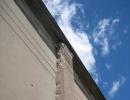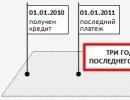Chapel of faith, hope, love and their mother Sophia. Church of Faith, Hope, Love and their mother Sophia at the Miusskoe cemetery
The temple belongs to the Trinity Deanery of the Moscow Diocese of the Russian Orthodox Church. At first, on the site of the stone church there was a wooden church, consecrated on January 20, 1773 in honor of one of the patrons of Catherine II, according to the vow given to her at the coronation to build churches in Moscow in honor of Saints Catherine, Sophia, and the saints whose memory day was the coronation. In 1823 In place of the wooden temple, a stone temple in the Empire style is being built. Funds for construction were allocated by the merchant of the first guild Ivan Petrovich Kozhevnikov. In 1834 chapels of the icon of the Mother of God “The Sign” and St. Mitrophan of Voronezh were added to the temple. Later, on the side of the western facade, two single-tier bell towers were erected above the chapels. Later, at the expense of guard ensign A.A. Neronova, a four-tier bell tower, an almshouse and the refectory were expanded (the northwestern and southwestern corners were added). In the early 1920s, St. Tikhon, Patriarch of All Russia, served in the church several times. From 1934 to 1990, the temple was closed, and the “Meduchposobie” equipment workshop of the Ministry of Health of the RSFSR was located on its territory. In 1990 the church was returned to the Russian Orthodox Church and services were resumed there.
At the Miussky cemetery, founded in 1771 during a plague epidemic near the area of Miussa (hence the name), a wooden church was built and consecrated in 1773 according to the vow made by Catherine II on the day of her coronation. The coronation fell on the day of remembrance of Catherine, Sofia, and other saints, and therefore the church was consecrated in honor of Faith, Nadezhda, Lyubov and their mother Sofia. In 1823, at the expense of the merchant I.P. Kozhevnikov, instead of a wooden one, a stone one was built in the Empire style (architect A.F. Elkinsky). In 1834-1835, the aisles of the Sign and St. were built on the sides. Mitrofan of Voronezh - at the expense of the guard warrant officer Alexandra Abramovna Neronova. The rite of consecration of the temple was performed by Saint Philaret (Drozdov), Metropolitan of Moscow and Kolomna. Later, on the side of the western façade above the chapels, symmetrically to the main axis of the temple, two single-tier bell towers were erected. In 1912, at the expense of the guard ensign A.A. Neronov, the temple was rebuilt, a four-tier bell tower was built, the refectory was expanded - the north-western and south-western corners were added, and an almshouse was opened at the temple. In the early 1920s, St. Tikhon (Bellavin), the All-Russian Patriarch, served in the church several times. In 1922, church valuables were confiscated from surviving churches and monasteries. The destruction of the temple at the Miusskoe cemetery took place on April 5, 1922, during the campaign to confiscate church valuables, “4 pounds 4 pounds 25 spools of gold and silver items” were confiscated from the temple. On January 1, 1933, in the Church of St. Renovationists served Vera, Nadezhda, Lyubov and their mother Sophia at the Miusskoe cemetery. In 1934, the temple was closed, the cross was knocked off, and the bell tower was broken down to the first tier. Behind the apses, on the sides of the dome and above the refectory, ugly extensions were made. The building of the temple houses the equipment workshop “Meduchposobie” of the Ministry of Health of the RSFSR. Until 1990, the temple was closed and rebuilt into civilian premises, the bell tower was destroyed down to the first tier. The temple was returned to the Russian Orthodox Church in 1990, and services were resumed here on September 28. The architectural and artistic appearance of the temple from the early twentieth century was recreated. The roof was replaced, which is now completely covered with copper, icons in icon cases took their place in the temple, and the walls were painted. On March 14, 2012, by order of Patriarch Kirill of Moscow and All Rus', a representative office of the Metropolitan District of the Russian Orthodox Church in the Republic of Kazakhstan was opened at the church. There is a Sunday school and library at the church. Shrines: the revered icon of the Mother of God “Quick to Hear”; the revered icon of the Mother of God “Theodorovskaya”; revered icon of St. mcc. Faith, Hope, Love and Sophia with relics; particle of the relics of St. Sebastian of Karaganda, Spanish; particle of the relics of St. mchch. Seraphim and Theognost of Almaty. The temple is open from 9 a.m. to 6 p.m.
In contact with
Temple at the Spiritual Rehabilitation Center at the Federal Scientific and Clinical Center for Pediatric Hematology, Oncology and Immunology. The project was completed by architects: Anisimov A. A., Batrakova Z. A., Zemlyakov I. S.
Construction of the temple
Construction of the temple began with the blessing of Patriarch Kirill of Moscow and All Rus'.
The basis for the construction was numerous requests from the parents of young patients of the Center in need of spiritual support and consolation, as well as the desire of the management and relatives to organize work on the spiritual, moral and socio-cultural education of children and youth undergoing treatment and rehabilitation at the Federal Scientific Center.
Andronik Faleychik, CC BY-SA 3.0On September 2, 2012, His Holiness Patriarch Kirill of Moscow and All Rus' performed the rite of great consecration of the temple.
On December 6, 2012, the consecration and raising of crosses on the domes of the temple took place.
Decoration of the temple
The temple is decorated with several carved reliefs, and in addition, a tiled frieze runs along it at mid-height. The tiles there are decorated with plant patterns and fairy-tale creatures, among which there is a beautiful fairy-tale bird. There are birds on carved reliefs as well. One, a fairy tale, sits on the western wall of the temple. And on the northern wall a Dove flies from the clouds.
Helpful information
Temple of the Holy Martyrs Faith, Hope, Love and their wise mother Sophia
Cost of visit
for free
Opening hours
- 24/7, external inspection
Address and contacts
Moscow, st. Miklouho-Maclay, ow. 4-10
Temple work
Only children undergoing treatment at the Federal Scientific Center and their parents are allowed into the temple.
Divine services are held systematically. Also, on a weekly basis, the catechist and priest, at the request of children and parents, visit them directly in the branches of the Center, where prayer services, the Sacraments of Confession, Communion, Blessing of Anointing are performed, and conversations are held on spiritual and moral topics.
On church holidays, children become participants in special events. So, earlier, on the Feast of the Annunciation, on the territory of the church still under construction, children, together with the priest and volunteers, released doves into the sky.
Spiritual care for children and parents, as well as staff, is provided by the St. Daniel Monastery and the Patriarchal Center for the Spiritual Development of Children and Youth operating under it. By a decree of His Holiness Patriarch Kirill dated July 31, 2012, Abbot Joasaph (Poluyanov), a resident of the Danilov monastery, the head of the Orthodox Church of the Russian Orthodox Church, was appointed rector of the church.
Church of the Holy Martyrs Vera, Nadezhda, Lyubov and their mother Sophia at the Miusskoye Cemetery appeared in the 18th century.
The name of the area Miusy, near which a cemetery was established during the epidemic of 1770-1771, has several versions of its origin.
So, according to one of them, in the 18th century Miusy was used as a lumber warehouse. It is not for nothing that in the 19th century this territory was called Miusskaya Lesnaya. According to another version, when at the mouth of the Mius River on the Sea of Azov, by order of Peter I, they began to build a harbor in 1696, a warehouse for construction materials was placed here.
There was also a legend among the people, according to which a certain Cossack Miyuska, an associate of Razin, was executed in this town.
The name of the area is also derived from the Turkic language, where the word “myus” means “corner, horn”.
From the history of the temple in Miussy
Mostly craftsmen, townspeople and merchants from nearby areas - Maryina Roshcha and Butyrki - were buried at the Miusskoe cemetery.
The first church near the cemetery was wooden. It was consecrated in 1773 in honor of the patroness Catherine II (the Empress, during her coronation, made a vow that she would build a shrine in Moscow in the name of those saints whose memorial day fell during the coronation).
In 1823, on the site of the old one, a stone church was erected in the name of the martyrs Vera, Nadezhda, Lyubov and their mother Sophia. The funds were donated by the merchant Kozhevnikov.
A little later, extensions were made to the temple - two chapels. They were built at the expense of A. Neronov, a guard ensign. Then two bell towers in one tier appeared near the temple - they were located symmetrically to the central axis of the church.
In 1912, the refectory was significantly expanded, an almshouse and a new four-tier bell tower were built.

Church after the revolution
In 1922, during the years of Soviet power, many churches were destroyed and church valuables were confiscated.
The shrine at the Miusskoe cemetery was no exception. Sad events in the history of this architectural monument fell on April 5, when most of the material assets were taken out of the temple.
In 1934 the church was closed. The bell tower was broken, the cross was removed. Ugly buildings were built above the refectory and behind the apses. Equipment from one of the “Meduchposobie” workshops took place in the temple.
In 1990, the temple was returned to the Russian Orthodox Church and services resumed in September.

Gradually the icons were returned to their place and the walls were painted again. The roof of the building was completely replaced - it was now covered with copper.
Date of creation: 1823 Description:Story
The Miusskoe cemetery was opened in 1771 during the epidemic of the plague. In 1773, the first wooden church was built here.
In 1823, on the site of a wooden building built by merchant I.P. Ko-zhev-ni-ko-va was built a now-defunct stone temple (architect A.F. El-kinsky). The consecration was performed by Metropolitan of Moscow Philaret (Drozdov).
In 1834, chapels were added to the church in honor of the Icon of the Mother of God “The Sign” and St. Mitrofan of Voronezh. Later, on the side of the western facade, two single-tier bell towers were erected above the chapels. In 1911-12 funded by A.A. Ne-ro-no-howl in the order of ko-lo-kol-nya and bo-ga-del-nya.
In the early 1920s. In the temple, St. repeatedly performed divine service. Tikhon, Patriarch of Moscow and All Rus'.
In 1934, the temple was closed, the cross was knocked down, the stake was destroyed down to the first tier, the temple building was subsequently rebuilt.
Divine service to the Zob-nov-le-ny on September 28, 1990. Under the leadership of the rector of the temple, Archpriest Boris Prisyazhnyuk (+2011), the architectural and artistic appearance of the temple of the early twentieth century was recreated. The roof was replaced, the walls were painted, and the icons were placed in icon cases.
The temple became the property of the Church by order of the Department of City Property of the city of Moscow dated February 10, 2017.






